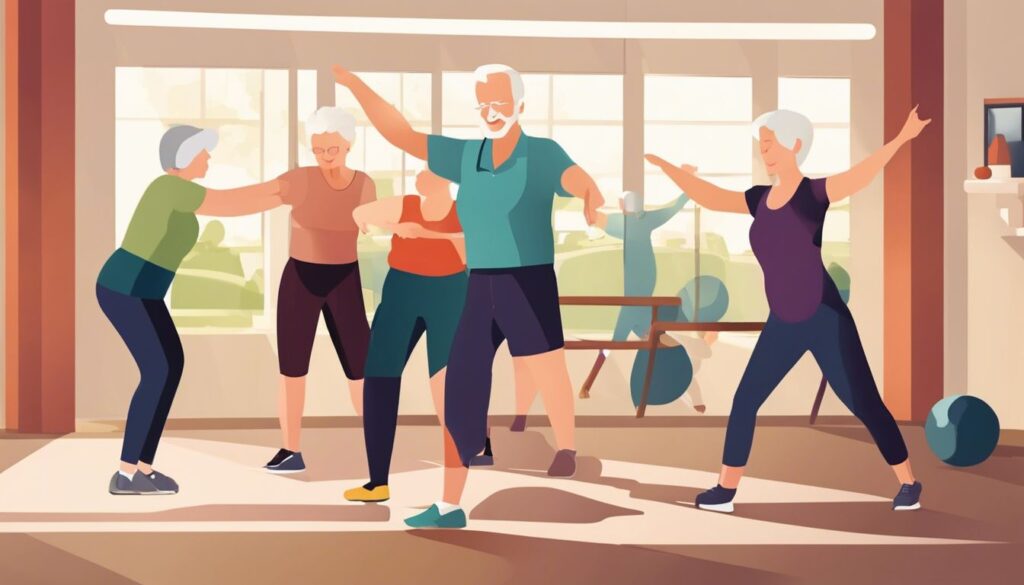Falls pose a serious risk for older adults, often leading to injury and loss of independence. Research shows that tailored exercise programs can reduce fall risk by up to 34%. This article outlines effective strategies to create exercise routines that improve balance, strength, and stability in seniors.
Learn how to design a safe and effective fall prevention program for older adults.
📋✅
- Exercise programs can cut fall risk by up to 34% in older adults by improving balance, strength, and stability.
- Effective fall prevention programs should include balance training, strength exercises, and activities like Tai Chi, which can reduce falls by 43%.
- Tailored exercise plans typically last 25 weeks and involve 52 hours of balance training, with Tai Chi programs running for 4 months and 45 hours of practice.
- Wearable devices and equipment like T-Bow© and wobble boards help monitor progress and enhance balance training for seniors.
- Community-based programs with small groups of under 10 participants have shown success, with one 12-week program cutting falls by 31% among older adults.
Understanding Fall Risks in Older Adults

Falls pose serious health risks for older adults. Aging affects balance and strength, increasing fall chances.
Importance of addressing balance and strength
Balance and strength training are crucial for reducing fall risk in older adults. Research shows that combining these exercises can decrease falls by 24%. Improving balance enhances stability during daily activities, while strength training builds muscle power to support safer movements.
Balance is the foundation of all movement. Without it, we lose our independence. – Dr. Jane Smith, Geriatric Specialist
Targeted exercises address age-related declines in muscle mass and coordination. Functional movements like sit-to-stand repetitions and Tai Chi practice directly improve real-world stability.
Regular strength training with weights or resistance bands maintains muscle tone essential for fall prevention.
Common contributors to increased fall risk
Aging brings physical changes that increase fall risk for older adults. Muscle weakness, particularly in the lower body, reduces stability and balance. Poor vision impairs depth perception and obstacle detection.
Chronic conditions like arthritis limit mobility and flexibility. Certain medications can cause dizziness or affect balance. Environmental hazards in the home, such as loose rugs or poor lighting, create tripping dangers.
Cognitive decline may impair judgment and reaction time.
Addressing these risk factors requires a multifaceted approach. Strength and balance exercises target muscle weakness. Regular vision check-ups help maintain good eyesight. Reviewing medications with a doctor can identify problematic side effects.
Home safety modifications remove tripping hazards. Cognitive training exercises may improve mental sharpness and decision-making. A comprehensive fall prevention program incorporates these elements to reduce risk holistically.
Key Components of Effective Fall-Prevention Exercise Programs
Effective fall-prevention programs focus on key areas to boost safety for older adults. These programs target balance, strength, and flexibility to reduce fall risks and improve overall function.
Balance training
Balance training forms a crucial component of fall prevention programs for older adults. Exercises focus on improving postural stability, proprioception, and reaction time. A systematic review found that effective balance interventions typically last 6 months, with participants engaging in 52 hours of training.
Tai Chi, single-leg stands, and tandem walks are common exercises that challenge and enhance balance skills.
Balance is the key to everything. What we do, think, say, eat, feel, they all require awareness, and through this awareness we can grow. – Koi Fresco
Physical therapists often incorporate specialized equipment like wobble boards and foam pads to create unstable surfaces. These tools progressively challenge an individual’s balance systems.
Group classes offer social benefits while allowing instructors to monitor proper form and safety. Regular assessments help track improvements and adjust difficulty levels as needed.
Strength training
Building on balance training, strength exercises form a crucial component of fall prevention programs. Strength training targets muscle groups essential for stability and mobility in older adults.
Research shows that combining strength exercises with balance training significantly reduces fall risk.
Effective strength training includes sit-to-stand exercises, which improve leg strength and body mechanics. Resistance bands, light weights, or bodyweight exercises can be used to build muscle strength.
A physical therapist can design a safe, personalized strength program tailored to the individual’s abilities and health conditions.
Flexibility and coordination exercises
Building on strength training, flexibility and coordination exercises further reduce fall risk in older adults. These exercises improve joint mobility and body awareness. Stretching routines target major muscle groups, enhancing range of motion.
Balance exercises like standing on one foot or walking heel-to-toe boost stability.
Tai Chi, a gentle Chinese martial art, combines flowing movements with deep breathing. Studies show Tai Chi decreases falls by up to 43% in older adults. Yoga also improves flexibility and balance through controlled poses and breathing techniques.
Both practices enhance proprioception—the body’s ability to sense its position in space.
Specific Exercises to Reduce Fall Risk
Targeted exercises can significantly reduce fall risk in older adults. These include balance training, strength building, and activities that improve coordination and flexibility.
Tai Chi and its benefits for stability
Tai Chi offers significant benefits for stability in older adults. Studies show it reduces falls by 19%, making it an effective exercise for fall prevention. Typical Tai Chi programs last 4 months, totaling 45 hours of practice.
This ancient Chinese practice improves balance, strength, and flexibility through slow, controlled movements.
Caregivers can encourage seniors to join Tai Chi classes or practice at home. The gentle nature of Tai Chi makes it suitable for most older adults, regardless of fitness level. Its focus on mindfulness and breathing also promotes relaxation and stress reduction, contributing to overall well-being.
Functional exercises like sit-to-stand
Building on the balance benefits of Tai Chi, functional exercises like sit-to-stand target everyday movements. These exercises boost leg strength, improve body mechanics, and enhance balance.
Sit-to-stand exercises mimic the act of rising from a chair, a crucial skill for older adults. Caregivers can incorporate these exercises into daily routines, starting with 5-10 repetitions and gradually increasing.
For optimal results, include sit-to-stand exercises in a 25-week balance and functional training program.
Resistance training for muscle strength
Building on functional exercises, resistance training targets muscle strength crucial for fall prevention. This method uses weights, bands, or body weight to challenge muscles progressively.
Studies show resistance training effectively increases muscle mass and power in older adults.
For caregivers, implementing a safe resistance program is key. Start with light weights and focus on proper form. Gradually increase resistance as strength improves. Aim for 2-3 sessions per week, targeting major muscle groups.
Exercises like leg presses, chair squats, and arm curls help build strength for daily activities and balance.
Walking regimens to improve gait stability
Walking regimens boost gait stability in older adults. Regular walks strengthen leg muscles and improve balance, reducing fall risks by up to 50%. A structured program typically includes 30-minute sessions, 3-5 times weekly.
Caregivers should start with short, flat routes and gradually increase distance and terrain complexity. Proper footwear and assistive devices like canes or walkers enhance safety during walks.
Monitoring heart rate and perceived exertion helps tailor the intensity to each individual’s fitness level.
Incorporating Technology and Equipment
New tech helps seniors stay safe. Wearable devices track balance and movement, while special boards improve stability.
Utilizing wearable devices for monitoring
Wearable devices revolutionize fall risk monitoring for older adults. These gadgets continuously track balance and activity levels, providing real-time data on performance. Caregivers can use this information to tailor exercise programs and make timely adjustments.
Smart watches, fitness trackers, and specialized sensors offer valuable insights into an individual’s progress and potential fall risks.
Incorporating wearable technology enhances the effectiveness of fall prevention strategies. The devices allow for precise measurement of gait stability, step count, and even sleep patterns.
This data helps healthcare professionals create personalized exercise regimens that target specific areas of concern. Next, we’ll explore how equipment like T-Bow© and wobble boards complement wearable technology in fall prevention programs.
Equipment like T-Bow© and wobble boards
Specialized equipment complements wearable devices in fall prevention programs. T-Bow© and wobble boards offer unique balance challenges for older adults. T-Bow©, a curved plastic board, improves core strength and stability through various exercises.
Wobble boards, unstable discs, enhance proprioception and ankle strength. Both tools provide safe, controlled environments for balance training. Physical therapists often incorporate these devices into tailored exercise routines.
Regular use of T-Bow© and wobble boards can significantly reduce fall risk in seniors.
Structuring a Tailored Exercise Program
Tailored exercise programs start with a thorough assessment of an individual’s fall risk factors. A physical therapist or qualified health professional can create a plan that targets specific weaknesses and builds on existing strengths.
Assessment of individual needs and risks
A thorough assessment of individual needs and risks forms the cornerstone of an effective fall prevention program. Physical therapists evaluate seniors’ balance, strength, and mobility using standardized tests.
These assessments identify specific risk factors like muscle weakness or poor coordination. Medical history reviews uncover conditions or medications that increase fall risk. The evaluation results guide the creation of personalized exercise plans targeting each senior’s unique challenges.
Individualized risk assessments lead to tailored interventions that reduce falls by 24%. Healthcare professionals consider factors such as vision impairments, chronic illnesses, and home hazards.
They analyze gait patterns and assess functional abilities like sit-to-stand performance. This comprehensive approach ensures exercises address the root causes of instability for each older adult.
Progressive intensity levels based on capability
Progressive intensity levels are crucial for effective fall prevention programs. Tailoring exercise difficulty to individual capabilities ensures safety and optimal results.
- Initial assessment: Evaluate balance, strength, and mobility using standardized tests.
- Beginner level: Start with simple exercises like chair stands and heel raises. Focus on proper form and technique.
- Gradual progression: Increase exercise duration and repetitions as strength improves. Monitor heart rate and perceived exertion.
- Intermediate level: Introduce single-leg balance exercises and light resistance training. Incorporate functional movements like stepping over obstacles.
- Advanced level: Add complex balance tasks, such as tandem walking or standing on unstable surfaces. Increase resistance in strength training exercises.
- Continuous monitoring: Regularly reassess progress and adjust intensity levels. Use wearable devices to track improvements in gait stability and balance.
- Individualized goals: Set specific, measurable targets for each participant based on their initial assessment and progress.
- Supervision: Ensure proper form and safety through guidance from physical therapists or trained professionals.
- Group classes: Offer different intensity levels within community-based exercise programs to accommodate various abilities.
- Home exercises: Provide tailored at-home routines to complement supervised sessions and maintain progress.
Frequency and duration of exercise sessions
Exercise frequency and duration play crucial roles in fall prevention programs for older adults. Effective balance and functional training typically spans 25 weeks. This extended period allows for gradual improvement and habit formation.
Tai Chi programs, known for enhancing stability, usually run for 4 months with a total of 45 hours of practice. Regular, consistent sessions help build strength, improve balance, and reduce fall risks.
Caregivers should aim to incorporate daily exercises, even if brief, to maintain progress and reinforce learned skills.
Role of Healthcare Professionals
Healthcare professionals play a key role in fall prevention for older adults. Physical therapists can create custom exercise plans based on individual needs and risks.
Guidance from physical therapists
Physical therapists play a crucial role in developing fall prevention programs for older adults. These professionals assess individual needs, create tailored exercise plans, and monitor progress.
They focus on improving balance, strength, and flexibility through specific exercises like Tai Chi and resistance training. Physical therapists also educate caregivers on proper techniques and safety measures.
Regular evaluations by physical therapists ensure exercise plans remain effective and safe. They adjust routines based on the senior’s progress and changing health conditions. Physical therapists collaborate with doctors to manage medications that may affect balance or increase fall risk.
Their expertise helps maximize the benefits of exercise while minimizing potential risks for older adults.
Regular evaluations and adjustments to exercise plans
Regular assessments of exercise plans are crucial for older adults. Healthcare professionals should evaluate balance, strength, and flexibility every 4-6 weeks. These check-ups allow for timely adjustments to the program, ensuring optimal fall prevention benefits.
Exercise intensity and duration can be modified based on progress, maintaining safety and effectiveness.
Tailoring exercises to individual needs is essential for reducing fall risks. A physical therapist might increase resistance training from 2 to 3 times per week or add more challenging balance exercises like single-leg stands.
Such personalized modifications maximize the impact of fall prevention efforts. The next section explores the role of healthcare professionals in guiding these exercise programs.
Community and Group Programs
Group exercise classes offer social benefits and motivation for older adults. Community programs can provide structured, safe environments for fall prevention exercises.
Benefits of group exercise settings
Group exercise settings offer significant advantages for older adults aiming to reduce fall risk. These programs foster social interaction, boosting motivation and adherence to exercise routines.
Participants benefit from peer support, shared experiences, and friendly competition, which can enhance overall engagement and enjoyment.
Effective group interventions typically involve fewer than 10 participants, allowing for personalized attention and tailored exercises. This small-group format enables instructors to monitor individual progress closely and adjust activities as needed.
The next section explores examples of successful community programs that have implemented these group-based strategies.
Examples of successful community programs
Community-based fall prevention programs show promising results. A study of 310 older adults participating in a 12-week balance and strength training program reported a 31% reduction in falls.
Another successful initiative, the Otago Exercise Programme, decreased falls by 35% in high-risk seniors through home-based exercises. These programs often combine group classes with individualized training, fostering social connections while addressing specific fall risks.
Tai Chi classes have gained popularity, with research showing up to a 55% decrease in fall rates among regular participants.
Safety Measures and Precautions
Create a safe exercise space free of trip hazards. Have a phone nearby and wear proper footwear during workouts.
Ensuring safe exercise environments
Safe exercise environments are crucial for older adults to reduce fall risks. Remove trip hazards like loose rugs or clutter from exercise areas. Ensure proper lighting, especially in bathrooms and bedrooms where falls often occur.
Install handrails and non-slip mats in showers and near toilets. Keep exercise equipment in good repair and use it as intended. Maintain comfortable room temperature and ventilation during workouts.
Supervision enhances safety during exercise sessions. Have a caregiver or exercise buddy present, particularly when trying new activities. Keep a phone nearby for emergencies. Wear appropriate, well-fitting footwear with good traction.
Stay hydrated and take breaks as needed. These precautions create a secure environment for older adults to improve strength and balance. Next, we’ll explore emergency procedures and support systems for exercise programs.
Emergency procedures and support
Building on safe exercise environments, emergency procedures and support are crucial for fall prevention programs. Caregivers must establish clear protocols for immediate response to falls or injuries.
These include having a phone nearby, posting emergency numbers, and keeping first aid kits accessible. Quick action can minimize complications from falls in older adults.
Training staff and participants in basic first aid enhances overall safety. Regular emergency drills help everyone stay prepared. Caregivers should also maintain updated medical information for each participant, including medications and allergies.
This data proves vital for emergency responders if an incident occurs during exercise sessions.
Medication Management in Fall Prevention for Seniors
Medication management plays a crucial role in fall prevention for seniors. Many medications, including antidepressants, sedatives, and blood pressure drugs, can increase fall risk by causing dizziness or affecting balance.
A healthcare professional should review all medications, including over-the-counter drugs and supplements, to identify potential risks. They may adjust dosages, switch to safer alternatives, or recommend discontinuing certain medications to reduce fall hazards.
Proper medication adherence is equally important in fall prevention. Seniors should use pill organizers, set reminders, or enlist caregiver help to ensure they take the right medications at the correct times.
Regular blood pressure checks and vision tests are essential, as these factors can be affected by medications and contribute to fall risk. Pharmacists can provide valuable guidance on drug interactions and side effects that may impact balance or coordination.
Encouraging ongoing participation in fall prevention strategies is vital for long-term success.
Encouraging Ongoing Participation
Tracking progress and celebrating milestones motivates seniors to stick with their exercise programs. Read on to learn more about effective fall prevention strategies for older adults.
Motivational strategies for sustained engagement
Effective motivational strategies boost long-term exercise engagement in older adults. Shared decision-making empowers seniors to set personalized goals, increasing program adherence.
Framing exercises as life-enhancing activities, rather than medical treatments, sparks intrinsic motivation. Caregivers can help track progress using simple charts or smartphone apps, celebrating small wins to maintain enthusiasm.
Group classes foster social connections and peer support, which often leads to improved participation rates. Setting achievable milestones and gradually increasing difficulty keeps exercises challenging yet manageable, promoting a sense of accomplishment and continued interest.
Tracking progress and celebrating milestones
Progress tracking motivates seniors to stick with fall prevention exercises. Caregivers can use simple charts or apps to record completed activities and improvements in balance or strength.
Celebrating small wins, like mastering a new exercise or increasing walking time, boosts confidence and encourages continued participation. These positive reinforcements help older adults see the tangible benefits of their efforts, reducing fall risks over time.
Regular assessments by healthcare professionals play a crucial role in tailoring exercise programs for older adults.
Conclusion
Tailored exercise programs reduce fall risk in older adults. Balance training, strength exercises, and Tai Chi form the core of effective interventions. Regular participation in group or individual sessions yields lasting benefits.
Healthcare professionals play a crucial role in assessment and program design. With proper guidance and safety measures, seniors can improve stability and maintain independence.
FAQs
1. What types of exercises help reduce fall risk in older adults?
Balancing, strengthening exercises, and aerobic activities like tai-chi improve stability. Resistance exercises and lifting weights build muscle strength. These physical activities enhance cardiovascular health and reduce fall risk.
2. How does aging affect fall risk?
The aging process causes vision changes, low blood pressure, and frailty. These factors increase the risk of falling. Exercise programs can address these issues and slow the effects of aging.
3. What role do health care professionals play in fall prevention?
Health care professionals design evidence-based exercise programs. They consider comorbidities like Parkinson’s disease or Alzheimer’s disease. Their expertise ensures safe, effective fall prevention strategies.
4. Are there specific exercises for seniors with limited mobility?
Yes. Chair exercises, Wii Fit games, and kitchen counter exercises work well. Physiotherapy can provide tailored programs for those in nursing homes or with mobility issues.
5. How do researchers measure the effectiveness of fall prevention programs?
Researchers use randomized controlled trials and systematic reviews. They employ time-to-event analyses, Cox regression models, and hazard models. These methods provide high-quality evidence on program effectiveness.
6. Can exercise programs address other health concerns besides fall risk?
Yes. Regular physical activity improves mental health, helps control hypertension, and may reduce cancer risk. It also aids in managing obesity, depression, and substance use disorders.









